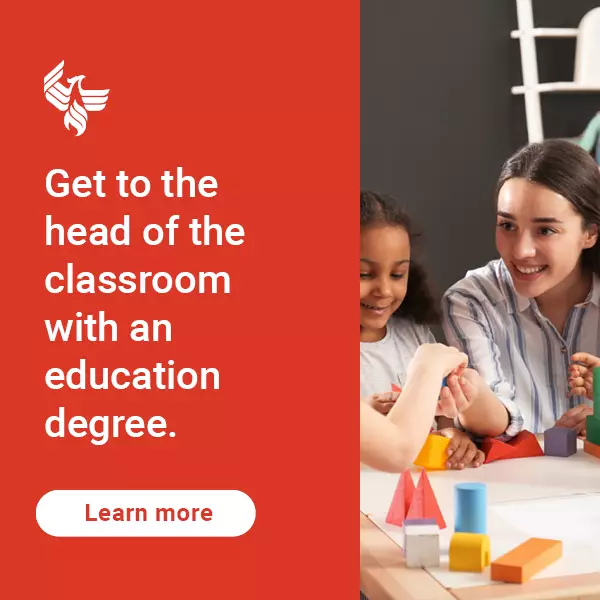5 online teaching strategies for the virtual classroom

At a glance
- Online teaching strategies are increasingly valuable as classrooms move into the virtual space.
- Five strategies for online teaching include offering a digestible takeaway for each lesson, covering topics students care about, providing multimedia resources, inviting students to create content to use in class and giving students time to reflect on the material.
- Active learning is another teaching strategy that focuses on engaging students in the classroom (whether virtual or online) for better lesson retention.
- University of Phoenix offers a Foundations in Virtual Teaching course for educators looking to enhance their mastery of this exciting new career pathway.
Learning to teach online
Did you know that you could teach online from potentially anywhere in the world? With many schools, including K-12 programs, offering hybrid or remote learning these days, online teaching may be an emerging career path for educators who know how to implement effective learning strategies to improve the classroom experience.
Even for those teachers who don’t plan to teach online exclusively, learning these online teaching strategies can be helpful. After all, being able to switch between in-person and virtual teaching environments is a skill that may be required in the future.
Teachers looking to make this shift — or to prepare for a potential return to virtual teaching — may want to consider expanding their knowledge of the emerging technology available to them and strategies for developing effective lessons, no matter which modality they use.
Because online learning is a growing pathway in K-12 education, there are many potential approaches to take. From exploring what “online teaching” means today to identifying the most effective strategies to reach online students, here what you need to know.
What online teaching formats exist?
As you explore the possibilities inherent to teaching online, it can be helpful to review the different formats available.
First, you should consider whether you prefer instructor-led or self-led classes. There is a significant difference between the two. Instructor-led classes are usually “live” in the sense that you can interact with students while the lecture or course is unfolding in your virtual classroom.
Another instructional strategy centers on self-led courses, which are the “manual” option for students: They generally watch prerecorded lectures on their own time. This asynchronous instructional format means students can catch up on coursework or lectures at any point before a certain deadline or before the next one is available to stream online.
These two systems offer different levels of flexibility and focus for both students and educators. Online students who choose self-led classes may have busy work and family schedules. That can make it hard to sit for live lectures at appointed times.
Online teachers enjoy similar flexibility with the self-led format. They can prerecord their lectures and upload them and other course content at any time of day before they are due online. This then frees them up to tackle other tasks, like grading, developing lesson plans or working on research or other projects within in their professional field.
What is distance learning?
Distance learning is conducted remotely and is often called “remote learning,” as it is usually facilitated entirely online with students and instructors separated by geography.
As explained in Education Corner, students in distance learning classrooms are instructed in one of four key ways:
- Virtual, online or internet-only classes
- Videos
- Live video sessions
- Alternative audio/visual technology platforms
“[Distance learning] enables people to receive education without having to be physically present in a classroom,” notes Education Corner, which is convenient for a variety of people and circumstances. Students juggling a full-time job, for example, or students living in remote areas who depend on home-based education can benefit from the accessibility offered by distance learning.
Fun fact: This is a concept that predates the internet: People once took correspondence courses, with lessons and answers delivered via pony rider!
Five strategies for online teaching
So, how do you make an online classroom as effective as an in-person one? Here are five proven ways online teachers can hit the mark:
- Break it down: Explain each subject and topic in a brief overview before you begin so students can identify the important takeaway. For example, stating, “The Confederacy lost the Civil War,” might be the takeaway or course lecture title, which you would then follow up with details on who, why and how.
- Keep it relevant: People pay attention when they care about the subject, so try to find a relatable angle, even if the topic seems otherwise removed. Studying Russian tsars might not seem like a topic most modern learners would care about, but making the connection to current U.S.-Russian relations can help spark engagement.
- Mix up your resources: Lectures have their time and place, but today’s teachers have access to a wealth of multimedia materials — and students benefit from them. Explore your options!
- Let students create content: The best way to master something? Create something. Invite students to develop a presentation, video or group discussion that can be implemented in the classroom.
- Give students time to reflect: It can be tempting to use every minute of class for active teaching, but it pays to build in time for student reflection. Asking, “Did anyone think of an example just now from your everyday lives?” can open the door to exploring a subject from a different angle and potentially understand it in a new way.
More methodologies for effective online teaching
No matter where you’re teaching, the following tips can help you maximize your instructional strategies.
- Record your classes. Livestreaming is hamstrung by the same time constraints as in-person classes. By recording and sharing your lectures, you give learners the ability to access them as it’s possible or convenient for them.
- Stay on camera. Staying visible while teaching online allows your students to feel connected and more comfortable engaging.
- Keep your videos snappy. Creating a dynamic teaching strategy means using media to support your lessons, not dominate them. Incorporate a variety of features like lectures, videos, discussions and breakout groups.
- Set your students up for success. When a lesson calls for an extended video, identify the window of time that is most important. If, for example, the crux of a video happens between 13 and 16 minutes, let your students know they need to see that part. (According to The Conversation, doing so can offer the added benefit of piquing students’ curiosity to watch the whole thing!)
- Do a presentation rehearsal. Practice makes perfect, even for teachers. Do a run-through for every lecture or classroom discussion you lead and draw on your teaching experience to make the online environment as impactful as a physical classroom.
- Include links. Offering more avenues for further reading empowers students to follow up as necessary.
- Use open source materials/public domain images. Anything else might prevent students from being able to access them.
- Make it interactive. As The Conversation recommends, consider a learning management system (LMS), which offers “a range of functions to create interactive learning activities such as quizzes.” Also, creating small groups for online discussions can create a more dynamic experience.
- Tie attendance to questions or quizzes. If students have to answer a question from your lecture to be counted as present, you’ll both good attendance and engagement with your lectures.
Read Similar Articles

11 qualities of a good teacher
Crack the code to classroom excellence!
What is an 'active learning teaching strategy?'
One teaching strategy that can be successfully implemented both in-person and online is the active learning approach. The idea behind this learning style is to engage students in the learning process so that, rather than passively receiving information (and retaining a questionable amount), students connect with the material and master it.
According to the Prodigy Game blog, active learning relies on eight main strategies. These are:
In these environments, teachers and students can ask questions, lead discussions and learn collectively.
Also known as the three-step interview, cooperative learning is like reciprocal questioning, except that students ask each other the questions and lead discussions among themselves, sometimes independently of the teacher.
With this approach, instructors take a breather every 10 or 15 minutes to let students reflect, discuss or reread materials and then contemplate them so they can better process and digest the information.
This technique involves asking students to concentrate on what is most unclear, confusing or difficult about a classroom discussion point. For example, this might be how to apply a specific rule of grammar to written text. From there, students discuss their struggles aloud or write out their issues with it so a teacher can see what’s wrong or missing from the student’s understanding.
- Devil’s advocate
This approach involves taking an opposing viewpoint and then trying to see “the other side” via debate or, more often, essay or other written form. This approach works best with controversial themes in history, current events, literature and related subjects.
By exploring an opposite viewpoint—and then debating or defending it—students learn to think critically and listen actively.
- Peer teaching activities
Because you have to learn something thoroughly in order to teach it, this type of activity can be very effective. Students can role-play, “buddy up” to study or actually teach one another assigned content or lessons.
- Game-based learning platforms
Everyone loves games, right? In an educational setting, games let students learn by doing — and have fun while they do it.
This can look a variety of ways. For instance, students may compete to solve a math problem faster. Or they may submit versions of the ending of a story and have others vote on the best one. (Following the latter, the teacher might ask students to explain why they think a piece of writing was more effective and popular.)
- Rotating chair group discussions
“Rotating chair group discussions encourage students to actively listen to selected speakers who follow a pattern of guiding class discussion and summarizing previous points,” explains the Prodigy blog. “Students lead and stimulate class discussion as they ‘rotate’ roles, repeatedly selecting the following speaker.”
Virtual instruction professional development opportunities
In order to transition from an in-person classroom to an online modality, or learn how to provide successful online learning experiences in general, teachers must understand the foundations of virtual teaching. This understanding often requires a knowledge of how to use the same skills, tools and platforms from the in-person classroom and apply them to an online course.
By learning how to design effective online experiences, educators can help strategically foster student engagement and enjoyment in the online classroom. Additionally, it is essential to be able to provide the same level of support to students through distance learning as in-person learning. This requires a fundamental knowledge of the latest online tools to aid learner success.
Online learning at University of Phoenix
To answer this growing demand for teachers who can facilitate effective virtual classrooms, University of Phoenix offers the Foundations in Virtual Teaching course. This single, noncredit, professional development course helps teachers transition from in-person, traditional classrooms to virtual, and potentially more flexible, instructional formats.
The Foundations in Virtual Teaching course focuses on key skills, including:
- Strategies for transitioning to online learning
- Virtual facilitation strategies
- Evaluation of technology-mediated assessment
- Building an online community
Click here to learn all about the Foundations in Virtual Teaching course, which offers an introduction to a valuable emerging skillset with just an estimated 30-hour learning commitment.
For those students who are considering a degree in education, University of Phoenix offers a nationally renowned program.
Curious to learn more? Read on for answers to some of our FAQs.
Q: When did University of Phoenix start offering online courses?
A: For more than three decades, UOPX has maintained a focus on online classes to help working adult learners achieve the education they seek.
Q: Can international students take University of Phoenix courses?
A: Yes. Depending on the degree program/coursework, students living abroad may be eligible to attend online. For more information, please contact a UOPX representative.
Q: Will I need to have a stable internet connection to take online classes or courses at UOPX?
A: To access our courses, you will need to have at least an intermittent connection. For more details about what technology is necessary, visit this page.
Q: What are the benefits of online learning, as opposed to traditional classroom learning?
A: Pivoting to a virtual classroom may give teachers greater flexibility to balance family time or give their students 24/7 access to classes. Teachers who are looking to add or switch to virtual classes might consider University of Phoenix’s online classes, which offer fixed, affordable tuition and a lifetime of career services support.
3 Business-Focused Career Paths with a Master’s in Adult Education
Online Degrees
August 09, 2023 • 7 minutes
IT Risk Management Guide: Definition, Framework, Education and Careers
Career Support
June 02, 2023 • 7 minutes



